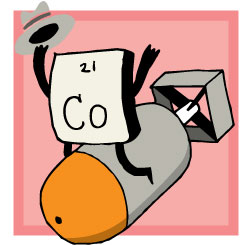Blogging the Periodic Table

In the novel A Canticle for Leibowitz, reckless world leaders have wiped out civilization in a win-at-all-costs nuclear war. The novel opens a few hundred years after this holocaust, with monstrous humans (some with two heads) loping around in the desert scrounging for food, and a colony of semi-literate Catholic monks trying to preserve civilization by hand-copying the few texts that survived the conflagration. But while the monks revere the scientific knowledge of the past, they remain wary of all technology. Their version of Vespers explicitly asks for protection from the radioactive elements that once rained down from the sky. And the first element they ask to be saved from is not uranium, plutonium, or hydrogen but another. "From the rain of the cobalt," the monks pray, "O Lord, deliver us."
Cobalt emerged as a terror during the Cold War (Walter Miller wrote A Canticle for Leibowitz in 1960) because it makes the dirtiest dirty bomb imaginable. "Conventional" nuclear warheads do much of their damage by incinerating people and flattening buildings. Dirty bombs kill almost entirely by radioactivity. The radioactivity from conventional warheads certainly kills, too, but there the radioactive fallout isn't as dangerous overall as in a dirty bomb. Conventional warheads rain down some elements that fire off their radioactivity quickly, depleting their ammunition. Other elements from warheads cling to their radioactive particles for thousands of years. But even though they continue to release radioactivity for a long time, they emit at such low levels that you're not in acute danger. You can wait out the worst of it in a fallout shelter.
Cobalt hits a sweet spot—it fires off just enough radioactivity upfront to kill you (or at least cause serious cancers), but holds onto enough reserves to make wherever the cobalt rain settles inhospitable for future generations, too. Calculations made in 1950 hinted that sprinkling one-tenth of an ounce of cobalt-60 on every square mile of earth (admittedly, a lot of cobalt overall) would wipe out the human race, a nuclear version of the cloud that killed the dinosaurs.
Salting the soil like this would not take genius-level engineering. Normal cobalt is cobalt-59. That means it has 59 neutrons plus protons, one neutron short of being deadly. Uranium warheads produce loads of neutrons, and merely surrounding a uranium warhead with a jacket of cobalt-59 would create plenty of cobalt-60. No government (as far as we know) has ever tried to make such a bomb—and some scientists suspect it wouldn't work as well as it's supposed to—but the idea does have a way of sticking in the imagination. That's why the monks prayed for deliverance from Element 27. It's also why, in Dr. Strangelove, the Soviet enemies have cobalt bombs.
Unfortunately, scientists are still working hard to create new types of bombs that exploit new elements—and some may turn out to be even worse, both militarily and politically, than the dreaded cobalt. To be continued tomorrow …
Like Slate on Facebook. Follow us on Twitter.